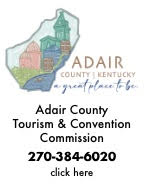| ||||||||||
Dr. Ronald P. Rogers CHIROPRACTOR Support for your body's natural healing capabilities 270-384-5554 Click here for details 


Columbia Gas Dept. GAS LEAK or GAS SMELL Contact Numbers 24 hrs/ 365 days 270-384-2006 or 9-1-1 Call before you dig Visit ColumbiaMagazine's Directory of Churches Addresses, times, phone numbers and more for churches in Adair County Find Great Stuff in ColumbiaMagazine's Classified Ads Antiques, Help Wanted, Autos, Real Estate, Legal Notices, More... 
|
MIKE WATSON: The Fight at Columbia in Which Capt. Jesse Carter was killed The following is an incident of the Civil War that was written by Judge Herschel Baker Jones and printed in the Adair County News in May 1898. In this description of the events of that fateful day, Judge Baker give a vivid description of the neighborhood, Burkesville Street, and the area around the Alexander and Cravens houses--as we know them, the Baker and Hurt houses. The wounded and dead were, at least in part, laid out on the side porch of the Cravens [Hurt] residence. Much local history is grounded in this old home and grounds. - MICHAEL C. WATSON This story posted as the Hurt/Cravens/Foust property enters a new chapter: See Brockmans are new owners of historic Foust property. The property has new owners, John & Julie Brockman, who were high bidders at the auction on Saturday, December 2, 2107. Click on headline for entire story Submitted by Michael C. Watson, Adair County Historian Morgan's Men--The Fight at Columbia in Which Capt. Jesse Carter Was Killed--An Unpleasant Situation of the Writer Just After the Battle Closed--Interesting Incidents--During the Civil War it was not known one day whom we would have with us the next. It might be Union soldiers, or Confederates, or neither. I remember one day walking up home in company with Col. Tim Cravens; he remarked to me, "we will have Confederate troops here very soon," and I asked him why he thought so. He said, "I just feel that way--something in the condition of the atmosphere makes me think so." I went home, ate my dinner, and going to my room, dropped down on the bed, and was just in the midst of a pleasant siesta when I was suddenly awakened by rapid shooting. I jumped up hastily, ran to the window, and looking out I saw a Union soldier going down the road at full speed, his head and body bent low on the side of his horse and a few feet behind him were four or five men in gray in hot pursuit, and shooting as rapidly as they could with pistols. The soldier in front was racing for life and liberty, and the men in pursuit seemed as eager to kill or capture him as he was to escape. I expected at every fire to see him fall from his horse, but, in less time than I have taken to tell it, they were over the hill in the direction of town and out of sight. Whether the soldier was ever hit, I never knew. In a few minutes afterward, the Confederates came back and took position behind a stable located near where Mr. George Kemp's residence now is, but they remained there only a short time, and then rode back over the hill beyond where Gov. Hindman's place is now located. When I left town two hours earlier, every thing was quiet, and no soldiers were supposed to be near us. The little dash I had seen down the road satisfied me that we had both sides represented, but in what force I could not tell. I took position at my window, an upstairs window, where I could see in both directions and waited further developments. The Confederate soldiers passed entirely out of sight, and in a few minutes I saw Union soldiers, cautiously making their way over the brow of the hill from the direction of town. Some of them took position behind the stable of which I have spoken, others behind a rail fence which then ran to the Burksville road near where Mr. Stults' house in now located; I saw another squad ride up behind the college. While this was occurring I noticed signs of activity over the hill in the direction the Confederate soldiers had gone. In my position I could see both parties, but they could not see each other. In a little while one gray coat and then another would slip over the hill and take position behind trees in an old apple orchard where the Rosenfield house is now located. Then the skirmish fire opened up from both sides--the Federals shooting from the college and from along the line of the old fence extending from the Burksville road up back of the Cravens place, while the Confederates were posted over the hill in the orchard. I do not know how long the firing continued, but for quite a while. The Federals were evidently, to my mind, deceived as to the force with which they were contending, for I could see that there were indications of quite an army over the hill where the Confederates were posted, and that they seemed to be preparing for some movement. Some of the Federal soldiers took position behind or near the Cravens residence, and after some time I noticed one or two of them creeping cautiously under my window and across the yard. Not wising them to enter the house, I ran down and locked the door, and returned to my former position of observation. About this time I saw a Federal officer on horseback riding up the road toward the Confederates, accompanied by five or six soldiers on foot, who were walking by the fence, half stooped, so as to escape observation from the enemy. The officer, although between the fires, rode quietly along in the middle of the road apparently indifferent to the danger. I expected every second to see him fall from his horse, as he was riding directly up to the Confederate line and was in easy range, and I would have been glad to warn him of his danger, but I could not do so, as the balls were whizzing in both directions, and he was beyond the reach of my voice. He evidently knew that it was not a safe place, but it was not discoverable in his manner. He had gone probably half way from my front gate to the top of the hill when I heard a yell, the like of which I had never heard before and never expect to hear again unless I join a regiment of Confederate veterans in the Cuban War--it was the Confederate war cry when advancing to battle--and at the same time I saw the line of soldiers as they dashed over the brow of the hill, and their shout seemed to extend from the Glasgow road around to the Crocus road. I never knew certainly who the Federal officer was, nor what became of him, nor the soldiers who were with him. When I heard the yell and saw the advance, and some of them seemed to be coming directly toward me, I felt it was about time for me to get away from the window, and seek safety at the back side of the house, which I did with becoming haste. It had been quite interesting up to that point. I had seen the smoke curl up after the shots, and had heard the whiz of the bullets. I had heard the war cry and seen the advancing line, and that was enough! When they reached our front door I opened it to them, and as the door came open a number of pistols came in, presented too, at my breast, while the holders of them demanded of me, "Where are the soldiers who fired at us from this house?" I told them that no soldier had been in the house nor fired from it, but, they had passed by the door and I had locked it purposely. With pistols still against me they insisted that shots were fired at them from the house. Just then I heard a voice say, "put your pistols down, boys, I know him, and whatever he says about it is true," and looking out I saw an old college friend. It was a very pleasant meeting under very unpleasant circumstances. I do not know what I said as he grasped my hand in a friendly shake, but I do know I was very glad to see him. The charge ended the fight. When I went out, one of the soldiers who had passed under the window was lying out near a side gate with a shattered leg which had to be amputated--three or four Confederates, who had been killed in the fight, were lying by the road on some boards which had been provided, and when I reached town, I learned that Capt. Jesse Carter, of Wolford's Cavalry, was shot through the body and was in a room at the hotel dying. Several others were wounded in the fight. The Confederates proved to be Morgan's command starting on that wonderful raid to the North and, they had been met here accidentally by a small scouting party of Federals, who went into the fight without knowing that they were engaging Morgan's command. I have always supposed that Capt. Carter was the Federal officer whom I saw ride up toward the Confederate line. It was like him. He was as brave as the bravest. The element of fear did not enter into his composition, and he had already won a reputation as one of the truest and most courageous of the men who followed the lead of Wolford and Adams. He was shot about 2 o'clock in the afternoon, and died about midnight. It has been said, but I do not know as to its truth, that Col. Adams had followed him with a small force and, arriving in the neighborhood of Columbia after the fight, and learning that his faithful Captain had been wounded and was dying, came into town in disguise while Morgan's forces were passing through--went to his room --talked with him, and remained by him until he died. Capt. Carter was a Cumberland County boy, whom I knew well--and entered the army from that county. Wolford often spoke of him as one of his most intrepid and dashing officers. He certainly bore himself in this fight as a fearless soldier. This was a mere skirmish--a hundred or so Federals on one side and three thousand Confederates on the other--but neither party knew at the time with what force it was contending. To me, sitting above the combatants where I could overlook the field and see every movement, it was of thrilling interest while it continued.--H.C.B., May 16, 1898. [Judge Herschel Clay Baker] This story was posted on 2017-12-05 09:43:16
Printable: this page is now automatically formatted for printing.
Have comments or corrections for this story? Use our contact form and let us know.
More articles from topic Mike Watson - History:
Mike Watson's Silent City tribute to Wm. Stewart just added Mike Watson: George W. Lawless, Wildcat killer Judge Rollin Hurt's History of Adair... Mike Watson: The Permanent Settlement of Adair County/II Mike Watson: The Permanent Settlement of Adair County The Time Gov. Happy Chandler Sang at the Adair Co. Courthouse MIKE WATSON : William Casey sketch from Judge Rollin T. Hurt Burro-Basketball game in 1954 raised funds for Grade Center History from Mike Watson: Adair County's Glenwood Seminary Mike Watson: How Eunice, KY got its name View even more articles in topic Mike Watson - History |



|
||||||||
|
| ||||||||||
|
Quick Links to Popular Features
Looking for a story or picture? Try our Photo Archive or our Stories Archive for all the information that's appeared on ColumbiaMagazine.com. | ||||||||||
|
Contact us: Columbia Magazine and columbiamagazine.com are published by Linda Waggener and Pen Waggener, PO Box 906, Columbia, KY 42728. Please use our contact page, or send questions about technical issues with this site to webmaster@columbiamagazine.com. All logos and trademarks used on this site are property of their respective owners. All comments remain the property and responsibility of their posters, all articles and photos remain the property of their creators, and all the rest is copyright 1995-Present by Columbia Magazine. Privacy policy: use of this site requires no sharing of information. Voluntarily shared information may be published and made available to the public on this site and/or stored electronically. Anonymous submissions will be subject to additional verification. Cookies are not required to use our site. However, if you have cookies enabled in your web browser, some of our advertisers may use cookies for interest-based advertising across multiple domains. For more information about third-party advertising, visit the NAI web privacy site.
| ||||||||||


















































